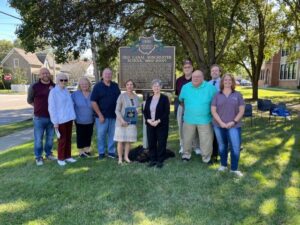, OH
The Lincoln Theatre, originally known as Ogden Theatre Lodge, opened on Thanksgiving Day in 1929. Developer Al Jackson was spurred to build the theatre because African-Americans were segregated from the other area theatres. Among the bands that have played at the Lincoln was the Eckstine Band, which launched the careers of a number of legendary jazz stars such as Dizzy Gillespie, Charlie Parker, and Sarah Vaughn. The Lincoln Theatre retained a high level of integrity during a period of unequaled African-American cultural, social, and economic strength in Columbus.
, OH
In 1798, Articles of Confederation Congress provided land to British Canadians who lost property because of loyalty to American revolutionaries during the American War of Independence (1775-1783). This land was part of the Refugee Tract and the present-day Truro Township. In 1850, Henry Stanbery, first Attorney General of Ohio, purchased a portion of this land. In 1923, Charles Johnson bought a section of this land and had it platted as the Eastmoor Addition by the Jennings-Lawrence Company with the polo field at the center. Eastmoor has houses ranging in age from the 1920s to the early 21st century, including Lustron homes built after WWII.
, OH
In 1795, the Connecticut Land Company auctioned twenty-five square miles of land known as Plum Creek Township. Aaron Olmsted, a sea captain, purchased almost half of the property. Although Olmsted died before ever seeing his land, in 1829, his son Charles offered to donate books to the area in exchange for changing the settlement’s name from Lenox to Olmsted. In 1815, shoemaker James Geer and his family became the first permanent American residents to settle in the southern end of the area. Geer’s farm was on what is now Columbia Road.
, OH
Over its 145 years, the Old Canal Winchester School building played a significant role in the community. The original four-room building opened in 1862 and its first high school class graduated seven in 1886. Canal Winchester’s growth is reflected in the school’s several additions, the first of which was in 1875. Other expansions include a separate high school building in 1909, a three-story connector in 1929 between the 1862 and the 1909 buildings, and elementary school wings in 1956 and 1967. The school was also the site of continuing education and vocational classes for adults in the 1930s and 1950s, agricultural programs for veterans after World War II, and a cannery from the time of that war to 1952. The school was added to the National Register of Historic Places in 2017 and it remains the district’s administrative center and a community gathering space.
, OH
On this site, Alexander Winton (1860-1932), an American automobile pioneer, built and lived in a lakefront estate named Roseneath. Winton was born in Scotland and immigrated to the United States as a young man, settling in Cleveland. In the early 1890s, Winton founded the Winton Bicycle Company; six years later, he incorporated the Winton Motor Carriage Company. In 1903, Winton’s auto plant on Berea Road was one of the largest in the world, and he produced the first car to cross America from coast to coast. These business successes enabled him to build the 25-room Roseneath. In 1912, Winton founded the Winton Gas Engine & Manufacturing Company, which would eventually become part of General Motors Corporation. Winton is buried in Lakeview Cemetery. A fire in 1962 destroyed Roseneath.
, OH
German immigrant Louis Rings (1826-1911) and his wife, Magdalena Wolpert (1835-1924), built their farmhouse in the early 1860s. As they prospered, the Rings purchased more land, added outbuildings, and grew their family. In 1904, the couple transferred land to their sons John and William. Although the farmhouse passed outside the family in 1929, descendants lived and farmed nearby until the 21st century. Farmsteads like Rings Farm provided the economic foundation for European immigrants to build Ohio communities. In Washington Township, Rings family members participated in the school board while Magdalena’s Wolpert family helped establish Dublin’s St. John Lutheran Church. Spreading development slowly converted the farm’s 150 acres to businesses and homes. In 1979, the Rings house and barns were listed on the National Register of Historic Places for their connection to Ohio’s agricultural development.
, OH
Bethel A.M.E. Church was the first African American church in Worthington. Black residents joined Worthington’s established churches as early as 1847 or worshipped together in their homes. Peter Banks with D.H. Taborn, Charles Kiner, J.T. Horton, and James Birkhead organized the A.M.E. congregation in 1896. Rapid growth moved their meetings to the Worthington Town Hall by 1897. A lot was purchased from Millie Alston on September 24, 1897, and a house relocated to serve as Bethel Chapel. Local carpenter Chester Hard constructed a new building that was dedicated as St. John A.M.E. in 1914. The church has served as the religious and social hub of Worthington’s Black community for more than a century. While St. John A.M.E. Church retains their original location, worship services moved to 7700 Crosswoods Drive in 2004.
, OH
Civil unrest rocked the Hough neighborhood for five nights during the summer of 1966.When the white owners of the Seventy-Niners Cafe refused to serve a Black customer a glass of water, a sign bearing a racial epithet subsequently appeared outside the bar. Decades of institutionalized racial practices that had caused Hough’s substandard and overcrowded housing, high unemployment, economic exploitation, lack of access to quality education, and systemic police harassment sparked an urban uprising in response on July 18. Angry crowds gathered outside the bar only to be confronted by the owners brandishing firearms. When the police belatedly responded, tensions escalated into targeted firebombing, looting, and vandalism. On Tuesday night, July 19, Cleveland’s Mayor Ralph Locher requested that the Ohio National Guard restore order. (Continued on other side)









